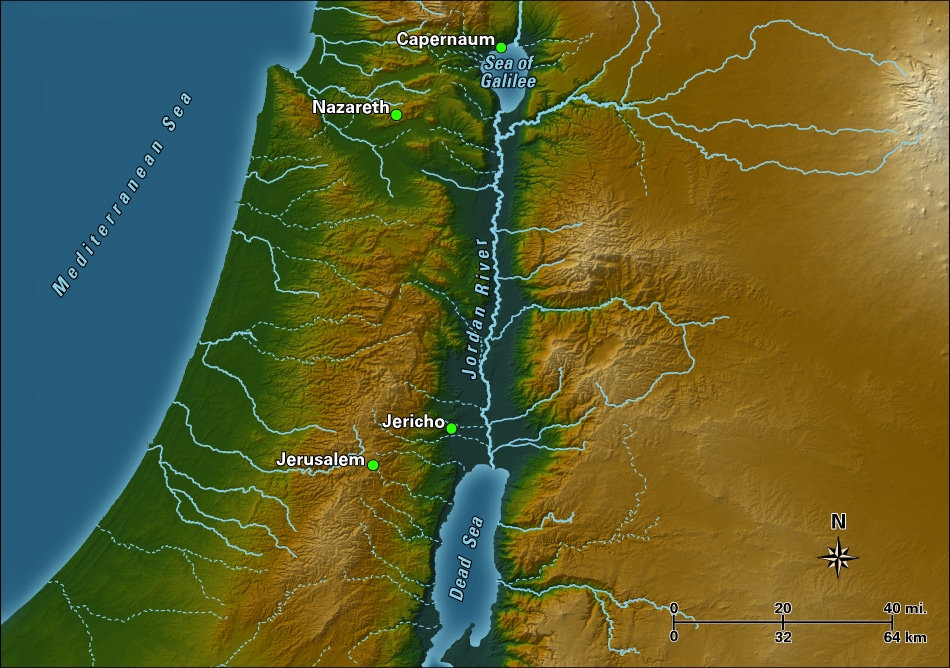
To listen to today’s reflection as a podcast, click here
Israel is a very small nation. All told it is just 10,175 square miles.
If it’s hard to make sense of that number, think of it this way: Almost seven Israels could fit into the state of Missouri.
Despite its small size, Israel has almost certainly had a greater impact on world history than any other territory – not simply because it lies at the intersection of three continents (Africa, Europe and Asia), but because one can make an excellent case that this humble stretch of land is where God chose to become a human being.
Israel is also home to two of the world’s most famous lakes. Both are still identified with the ancient label “sea,” and both are primarily fed by the same flowing stream – the Jordan River.
But that’s where the similarities between the Sea of Galilee and the Dead Sea come to an end.
Israel’s eastern boundary is part of an extraordinary geological feature known as the Great Rift Valley, which extends far south through the Red Sea, all the way across the eastern flank of Africa. It’s helpful to picture the valley, at least where it runs alongside Israel, as a kind of slide that gradually descends from north to south.
The high point is somewhere in present-day Syria, not far from snow-capped Mount Hermon. Melted snow becomes the Jordan River, which then heads downhill – south, that is – toward Galilee.
That’s where the Jordan pours into the Sea of Galilee, an enormous freshwater lake. At 700 feet below sea level, it is the second lowest body of water on the planet. It teems with fish, and ancient Roman authors excitedly declared that its waters were sweet enough to drink (although we should pause here to say this is definitely not recommended in the 21st century).
The village of Capernaum, situated along the lake’s northwest shore, appears to have been the base of Jesus’ ministry operations. We know that Peter lived in Capernaum, as well as, presumably, a number of the other disciples who were fishermen by trade.
Many of the Gospels’ most memorable accounts happened on or around the Sea. This is where Jesus taught the crowds. And healed the sick. And miraculously fed thousands of people. And walked on water. And stilled the wind and waves of at least one fierce storm with a single word.
Just as the Sea of Galilee receives the Jordan River, it also surrenders or gives up the Jordan River. Israel’s only major surface stream continues flowing to the south, down the valley’s gentle slide.
Approximately 100 miles later, it arrives at the Dead Sea. And that’s where it stops. That’s where everything stops.
That’s because the Dead Sea is the lowest point on the surface of our planet – a full one-third of a mile below sea level. It’s not shallow, either. At one spot it’s 997 feet deep.
Geologists assert that the Sea is the world’s saltiest body of water. Since the lake has no outlet, it is the final repository of numerous minerals that are steadily leached into its waters from the nearby wilderness. With a saline concentration approaching 34%, it is nearly ten times saltier than the world’s oceans. That means the Dead Sea, true to its name, is almost entirely devoid of life. Apart from a few exotic microorganisms, nothing can live within its waters or along its shores.
The Dead Sea is like a sink trap. It’s the end of the line. Everything that goes there stays there.
There are no Gospel stories involving the Dead Sea. The Bible’s primary text concerning this part of Israel is found in Genesis 19 – the spectacular destruction of Sodom and Gomorrah. The remains of those two infamous towns are thought to be concealed somewhere beneath the shallow waters at the northern end the Sea.
About a century ago, New York City preacher Harry Emerson Fosdick pointed out that the Sea of Galilee and the Dead Sea are made from the same water.
He wrote, “It flows down, clear and cool, from the heights of Hermon to the roots of the Cedars of Lebanon. The Sea of Galilee has an outlet – it gets to give. It gathers in its riches that it may pour them out again to fertilize the Jordan plain. But the Dead Sea, with the same water, makes horror, for the Dead Sea has no outlet.”
That’s the difference between the two lakes: outflow vs. stagnancy. One lake is alive and gives life away. The other is dead and kills everything that touches its banks.
Your life is an imitation of one of those bodies of water. As God’s blessings come your way – whether riches, talents, opportunities, hope, or joy – you have two essential choices.
You can decide that you are “blessed to be a blessing” – that the good things in your life have come to you from God because they are on their way to someone else.
Or you can decide that your blessings belong to you. Period. Which means you’ll wrap your hands (and your heart) around the things you value the most, insist that you have earned them, and become a spiritual hoarder.
And you will die. Just like the Dead Sea. What will die, slowly but surely, is your capacity to experience the fullness of God’s love and God’s joy – not only with him but with others.
All of us are receivers.
What we choose to do with that reality makes all the difference.
Will you try to cling to your own blessings?
Or will you choose – with God’s help and power – to give your life away as a blessing for the sake of others?
